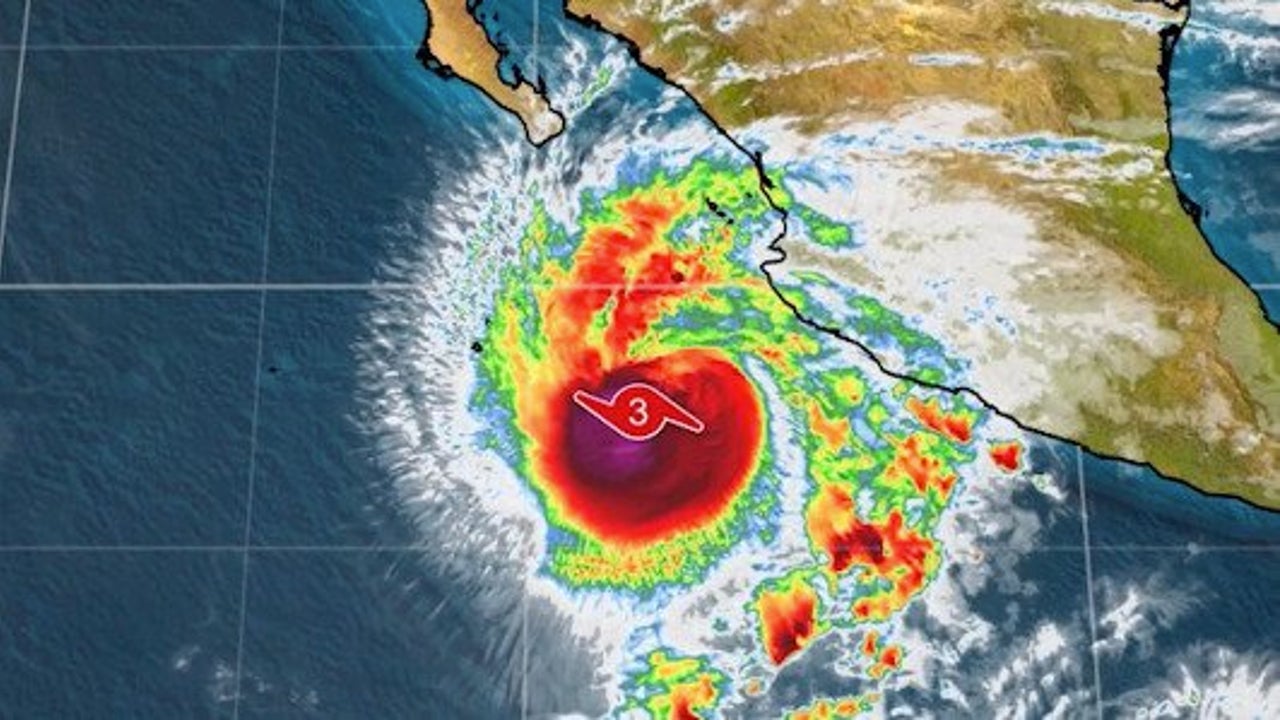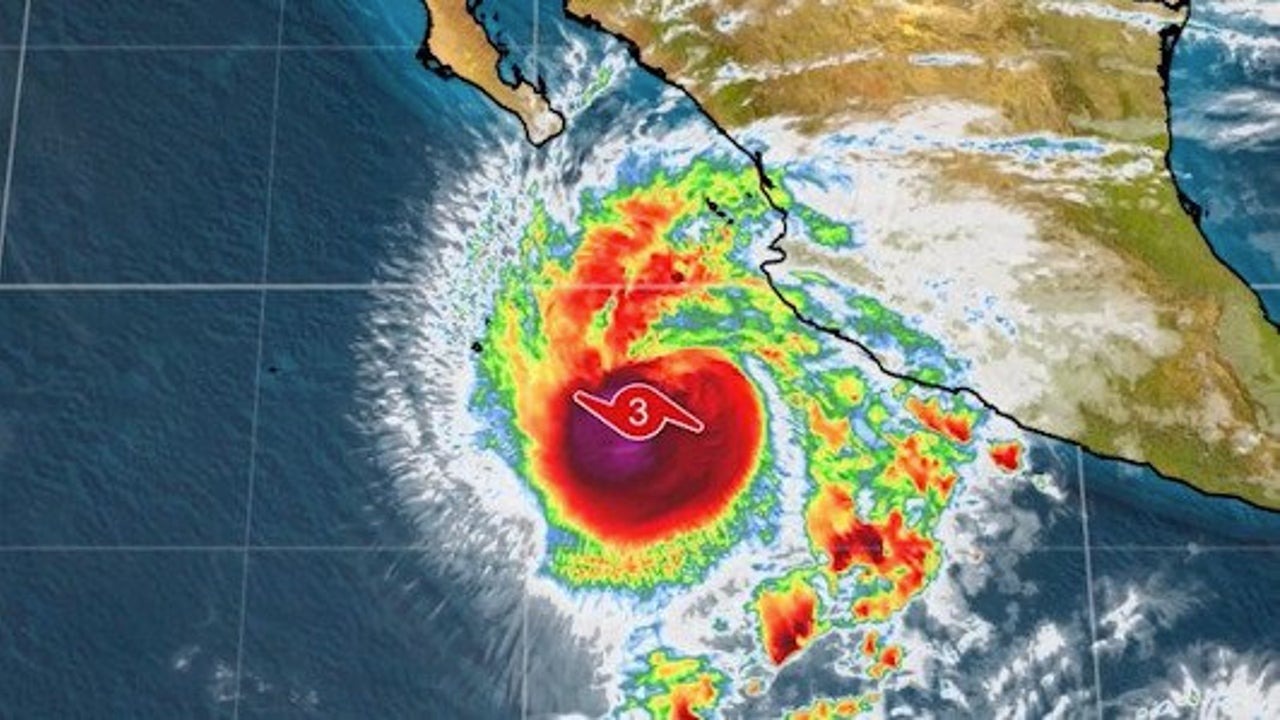Hurricane Flossie has officially strengthened into a Category 3 major hurricane off Mexico’s Pacific coast, according to the U.S. National Hurricane Center (NHC). The powerful storm, which has been closely monitored over the past few days, reached sustained winds of 185 kilometers per hour (115 mph) late Tuesday, placing it in the “major hurricane” category under the Saffir-Simpson Hurricane Wind Scale.
Although Flossie’s center remains well offshore, its outer rain bands have begun affecting coastal areas, bringing heavy rain, gusty winds, and elevated surf to parts of Michoacán, Colima, and Jalisco.
Where Is Hurricane Flossie Now?
As of the latest advisory issued by the NHC, Hurricane Flossie is located approximately 505 kilometers (315 miles) south-southeast of Cabo San Lucas, one of Mexico’s most visited resort cities. The storm is moving west-northwest at 17 kph (10 mph) and is expected to maintain this general motion for the next 24 to 36 hours.
Forecasters say Flossie could experience some additional strengthening through Wednesday before gradually beginning to weaken later in the week, particularly as it moves over cooler waters and less favorable atmospheric conditions in the Pacific Ocean.
What Areas Are Currently Affected?
Although the core of Hurricane Flossie is not forecast to make landfall, outer rainbands have already begun to impact several western coastal states in Mexico, including:
-
Michoacán
-
Colima
-
Jalisco
These areas are experiencing intermittent heavy rain, localized flooding, and rough coastal surf. Officials have warned that some mountainous and low-lying areas may be susceptible to flash flooding and landslides, especially where soils are already saturated.
The Government of Mexico discontinued an earlier tropical storm warning that extended from Punta San Telmo to Playa Pérula, suggesting a lowered risk of tropical storm conditions reaching inland. However, forecasters continue to advise caution due to potential rain-related hazards.
What to Expect in the Coming Days

1. Further Strengthening and Then Weakening
The National Hurricane Center notes that Flossie may strengthen slightly over the next 12 to 18 hours before encountering less favorable conditions. The hurricane is not expected to maintain its Category 3 status for long, with gradual weakening predicted by Thursday.
2. No Direct Landfall Forecasted
Current computer models and tracking data show Hurricane Flossie remaining offshore, moving in a northwest direction away from the Mexican coastline. This track significantly reduces the likelihood of direct hurricane-force impacts on land.
However, tropical moisture associated with the system will continue to bring showers and thunderstorms to the southwestern coast of Mexico through midweek.
3. Hazardous Marine Conditions
Boaters and coastal residents are being urged to exercise extreme caution. Strong rip currents, large waves, and sudden gusts could endanger small craft and beachgoers. Authorities recommend avoiding coastal areas until the storm system moves farther out to sea and conditions improve.
Mexico’s Emergency Response and Monitoring
The Secretariat of the Navy (SEMAR) and National Civil Protection System have activated preventive protocols in the Pacific region, particularly in areas with previous storm vulnerabilities. Emergency shelters remain on standby in vulnerable municipalities, and local governments have been advised to monitor river levels and landslide-prone zones.
Mexico’s National Meteorological Service (SMN) continues to issue updated forecasts, radar images, and risk alerts. Residents are encouraged to stay informed via official communication channels and not to rely on rumors or unverified social media posts.
Impact on Travel and Tourism
Cabo San Lucas and surrounding resort towns are closely watching the hurricane’s progress. Although the storm is not projected to make landfall, rough seas and possible travel delays are anticipated.
Airlines operating flights to and from Baja California Sur may experience disruptions due to storm proximity. Cruise ships navigating along the Pacific coast have already begun adjusting their routes to avoid hazardous conditions.
Local tourism boards have issued statements assuring travelers that precautionary measures are in place, and current forecasts do not indicate a direct threat to the region’s resorts or residential areas.
Pacific Hurricane Season Context

Hurricane Flossie is one of the early major hurricanes of the 2025 Pacific hurricane season, which runs annually from May 15 to November 30. Climate analysts have indicated that warmer sea surface temperatures and shifting atmospheric patterns may lead to more frequent and intense storms this year.
According to the National Oceanic and Atmospheric Administration (NOAA), the eastern Pacific basin averages 15–20 named storms per season, with approximately four to five major hurricanes developing each year.
Safety Tips for Coastal Residents

Even when hurricanes remain offshore, their influence can still be felt inland. Authorities are urging residents in affected states to:
-
Stay informed through official weather services such as SMN and NHC.
-
Avoid unnecessary travel in affected coastal or mountainous areas.
-
Secure outdoor belongings that could be impacted by strong winds or heavy rain.
-
Follow local government instructions and be prepared to relocate if necessary.
-
Avoid beaches and rivers, as tides and water levels may rise unexpectedly.
Final Outlook
While Hurricane Flossie currently poses no immediate landfall threat, its classification as a Category 3 storm reinforces the importance of preparedness and monitoring, even for offshore systems. The storm’s influence will likely persist through Wednesday across parts of western Mexico before it begins to weaken as it heads farther out into the Pacific Ocean.
Emergency services remain active, and residents in Michoacán, Colima, and Jalisco are advised to remain cautious and aware of any changes in the storm’s forecast path.




